Total fires 9,093 | Dates 20 Oct 2007 – 9 Nov 2007 | |
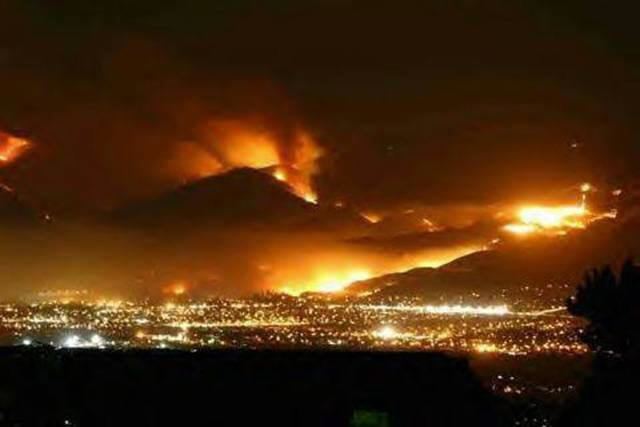 | ||
Total area 1,087,110 acres (4,399.4 km) Location Southern California, California, United States Similar 2014 California wildfires, Sand Fire, 2009 California wildfires, Blue Cut Fire, 2015 California wildfires | ||
October 2007 california wildfires
The 2007 California Wildfire Season saw over 9,000 separate wildfires that charred 1,087,110 acres (4,399.4 km2) of land. 30 of those wildfires were part of the Fall 2007 California firestorm, which burned approximately 970,977 acres (about 3,900 km², or 1,500 mi²) of land from Santa Barbara County to the U.S.–Mexico border, surpassing the October 2003 California wildfires in scope, which were estimated to have burned . At the peak of the wildfire activity in October 2007, the raging wildfires were visible from space.
Contents
- October 2007 california wildfires
- Fires
- San Diego County
- Other fires
- Los Angeles and Ventura counties
- San Bernardino County
- Riverside County
- Baja California
- Wind and weather
- Impact
- Air quality and effects on health
- Response
- References
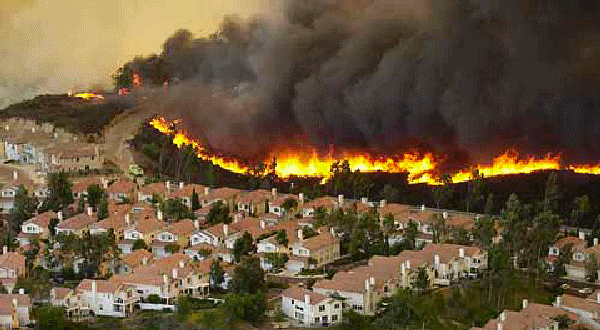
The wildfires killed a total of 14 people, with nine of them dying directly from the fires; 160 others were injured, including at least 124 firefighters.
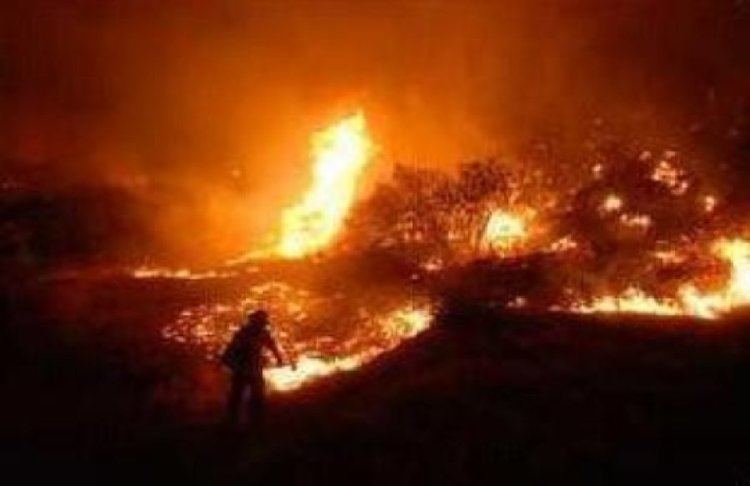
California Governor Arnold Schwarzenegger declared a state of emergency in seven California counties where fires were burning. President George W. Bush concurred, and ordered federal aid to supplement state and local response efforts. Over 6,000 firefighters worked to fight the blazes; they were aided by units of the United States Armed Forces, United States National Guard, almost 3,000 prisoners convicted of non-violent crimes, and 60 firefighters from the Mexican cities of Tijuana and Tecate. The fires forced approximately 1,000,000 people to evacuate from their homes, becoming the largest evacuation in California's history.

Major contributing factors to the extreme fire conditions were drought in Southern California, hot weather, and the strong Santa Ana winds with gusts reaching 85 mph (140 km/h). California's "fire season," which traditionally runs from June to October, has become a year-round threat due to a mixture of perennial drought and the increasing number of homes built in canyons and on hillsides surrounded by brush and forest.
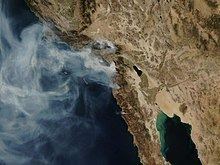
The fires had numerous sources. Several were triggered by power lines damaged by the high winds. One fire started when a semi-truck overturned. Another was suspected as having been deliberately caused; the suspect was shot and killed in flight by state authorities. A 10-year-old boy admitted that he accidentally started the Buckweed Fire by playing with matches. Causes of the remaining fires remain under investigation. The last fires, the Santiago and Poomacha Fires, were fully contained on November 9, 2007, about 19 days after the series of wildfires had begun to ignite.

During the season, the National Interagency Fire Center reports that two firefighters were killed. One died via helicopter and the second in a bulldozer rollover.
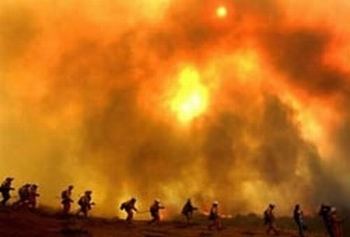
Fires
Below is a list of all fires that exceeded 1,000 acres (4.0 km2) during the 2007 fire season. The list is taken from CAL FIREs list of large fires.
San Diego County
Of all the wildfires, the two largest ones were located in San Diego County. The largest, the Witch Creek Fire, burned areas in north and northeast San Diego County. The second largest, the Harris Fire, burned northwest from the U.S–Mexico border towards San Diego. Officials feared that the fires could become even more destructive than the 2003 Cedar Fire that burned 280,278 acres (1,134.2 km2), destroyed 2,820 buildings (including 2,232 homes), and killed 15 people (including one firefighter) before being contained on November 3, 2003. Though individually the fires did not surpass the Cedar Fire, if combined as one, they did.
Residents were subjected to a mix of mandatory and voluntary evacuations, depending on the projected path of a fire. Hundreds of thousands of residents were notified of evacuations via a computerized Reverse 911 phone call system. While this alert system was mostly effective, many residents in Rancho Bernardo received the calls after they had been driven from their homes. On the other hand, in Carmel Valley, only the northern half was officially evacuated, but a computer error mistakenly sent Reverse 911 calls to the southern half as well. Law enforcement officers also notified residents by driving through evacuation areas. On October 24, 2007, San Diego County Sheriff Bill Kolender stated that the number of people evacuated in San Diego county had exceeded the number evacuated from New Orleans, Louisiana during Hurricane Katrina.
Two days into the fires, approximately 500,000 people from at least 346,000 homes were under mandatory orders to evacuate, the largest evacuation in the region's history. Evacuation sites included Qualcomm Stadium, as well as many schools, civic centers, and churches throughout the area. The American Red Cross managed the evacuation centers.
Officials estimated that 12,000 gathered at Qualcomm. Volunteers provided food, blankets, water, internet services, children's toys, massages, and a live rock band performance for those at the stadium. Nearly all public schools and universities in the San Diego area were closed. Many businesses closed as well. To ensure clear roads for emergency vehicles, San Diego mayor Jerry Sanders asked residents to stay home and inside.
By October 23, some evacuations were lifted, allowing about 50,000 residents from the cities of Del Mar, Chula Vista, and Poway, and the San Diego neighborhoods of Del Mar Heights and Scripps Ranch to return home. However, the fires continued and damage was severe. The four major fires across San Diego County burned nearly 300,000 acres (1,200 km2) and destroyed or damaged 1,350 homes and 100 businesses since October 21, 2007.
Many major roads were closed as a result of fires and smoke. On October 22, the California Highway Patrol closed Interstate 15 in both directions between State Routes 78 and 56. On October 24, 2007 the Horno Fire forced the closure of Interstate 5 as well as the Amtrak Surfliner service between Oceanside and San Clemente. Traffic from Interstate 5 was diverted to Interstate 15, which had reopened.
Officials from the San Diego Wild Animal Park said that its more than 3,500 animals were safe staying in their enclosures where they were protected by the park's fire break and irrigated areas. If the weather conditions worsened, the animals could retreat to their watering holes. However, many critically endangered animals such as the California condor were moved to the park's veterinary hospital, which is fire-resistant and fully equipped with sprinklers. Park spokesperson Yadira Galindo said that the animals were "alert but not showing any concerned behavior."
Other fires
Los Angeles and Ventura counties
Numerous fires burned in Los Angeles and Ventura Counties.
San Bernardino County
Riverside County
Baja California
Fires also burned in northern parts of the Mexican state of Baja California. The Harris Fire burned near Tecate, and fires burned near Tijuana as well.
More than fifteen thousands hectares were consumed by the wildfires in Baja California. Tijuana, Tecate and Ensenada were the municipalities more affected by the fire. In total there were seven fires caused by Santa Ana winds. The community of Maneadero, in the highlands of Ensenada, was the most affected.
Wind and weather
The fires occurred at the end of a dry summer and were exacerbated by the seasonal Santa Ana winds. The San Diego Union Tribune reported, "Santa Ana winds blowing up to 60 mph (97 km/h) combined with temperatures into the 90s to create in the worst possible fire conditions." At one point swirling winds threatened to bring fire into densely populated urban areas.
Southern California was in the midst of an unusual drought; in Los Angeles, with only 3.21 in (82 mm) of precipitation in 2006–2007, it was the driest year on record. The combination of wind, heat, and dryness turned the chaparral into fire fuel. Officials believed that some of the fires generated their own winds, similar to the Oakland Firestorm of 1991. The effects of the smoke were felt as far away as Brentwood, California (in the East Bay, near Stockton), where it impacted local weather. The high-speed Santa Ana winds also rendered the use of dropping water from fire fighting aircraft inefficient; until such winds abate, most payloads of water are just dispersed by the wind over an area so large that the water evaporates before it can reach a large fire on the ground.
Impact
On October 21, the Harris Fire damaged and disabled the Southwest Power Link, a 500,000-volt power line from Arizona to San Diego. Power outages were reported in Los Angeles, Orange, San Diego, and other counties on October 22 to 333,500 Southern California Edison customers, most being restored within 24 hours. The power outage also affected the areas of Ojai, Oxnard, Simi Valley, Santa Clarita, Thousand Oaks, Agoura Hills, Rialto, Fontana, San Bernardino, Rancho Cucamonga, Mira Loma, Hesperia, Corona, Bloomington, Irvine, Calimesa and Rubidoux. This outage also caused 230 people to be without power in Malibu. The California Independent System Operator Corp declared an energy transmission emergency in southern California on October 23, due to wildfires affecting the lines. 500,000-, 230,000- and 138,000-volt lines were disabled in San Diego, and some lines in other areas were also disabled. 24,992 people lost power, due to the lack of power from the power grid. During the crisis, Mexico provided power to help augment the electrical needs of the San Diego area.
Authorities have stated that the evacuations, which displaced more than 900,000 people, have been the largest evacuation number in the history of California. By mid-morning on October 22, 2007, thousands of evacuees were taking shelter in Qualcomm Stadium and other locations throughout San Diego. On the afternoon of October 22, 2007, the Marines evacuated some planes from Marine Corps Air Station Miramar to other military bases in California and Arizona. The Navy moved all non-essential personnel from Naval Base San Diego barracks onto nearby vessels to accommodate refugees. The San Diego Wild Animal Park moved some animals to the on-site animal hospital for their protection.
The Horno Fire had charred 6,000 acres (24 km2) in Camp Pendleton by 4:00 A.M PDT, on October 24, 2007. It caused the closure of Interstate 5 and it also caused Amtrak to stop Surfliner service between Oceanside and San Clemente. Traffic was being diverted to Interstate 15, which had itself been closed earlier. Illegal migrant workers were endangered by the crisis, sometimes staying at work in the fields within mandatory evacuation zones. Many had lived in the canyons nearby and distrusted officials. When fleeing the fires, some were arrested, while others were turned away from shelters due to lack of adequate identification. Some Mexican firefighters expressed concern about their countrymen, while others felt the migrant workers were aware of the risks they were taking.
Only a few cases of looting were documented. Six people were arrested for stealing supplies from Qualcomm stadium, another was arrested for theft after being found in possession of stolen goods in the Jamul fire area, and two were arrested near the Tecate border crossing.
Air quality and effects on health
The concentration of particulate matter 10 micrometers and smaller (designated PM10) reached unhealthy levels as a result of the fires. PM10 particles are small enough to enter deep into the lungs, and possibly the bloodstream. San Diego city attorney Michael Aguirre, citing concerns over weather conditions and air quality, urged the city to consider a voluntary evacuation of the entire city.
Response
Government agencies and volunteers worked together to mitigate the effects of the fires. According to the state of California's Consolidated Response web page, "There are 17 active fires in Southern California. The priority for fighting fires as of 19:30 on October 21 is the Buckweed, Witch, Harris, Canyon, Ranch, Santiago, and Sedgewick Fires." March Air Reserve Base is the primary staging area for relief supplies as coordinated by the Federal Emergency Management Agency.
With many businesses and schools closed, some people used their time off to help others. Officials estimated that 10,000 people were gathered at Qualcomm Stadium, the largest shelter point in San Diego. Besides food, blankets and water, volunteers provided toys for children, massages, and a live rock and roll band performance. CERT teams, in various cities, received their first activation since the program's inception in this region. Trained volunteers provided assistance ranging from coordinating relief, to acting as a fire department auxiliary. Religious groups such as Victim Relief Ministries, Giving Children Hope, Hope Force International, Apostolic World Relief, and the Salvation Army responded by opening places of worship, donating supplies, and feeding workers and evacuees.
The Department of Defense contributed twelve engines for firefighting efforts. The National Guard called more than 2,400 troops, with 17,000 available if needed; of which 100 California National Guard medical personnel provided medical assistance. Six crews from the Navy's Helicopter Sea Combat Squadron 85 based at Naval Air Station North Island were assigned to battle the Witch Creek fire. They flew MH-60 Seahawk helicopters equipped with a 420-gallon water bucket and they were the only local Navy teams trained to fight fires from the air. Marine Corps Air Station Miramar contributed several aircraft as well as fire fighting trucks to operations based in Ramona. One of the larger airtankers, the Martin Mars, sent through a private contract from its home in Port Alberni, British Columbia on October 25, landing on Lake Elsinore in Riverside County, California. It has a 7,000 gallon capacity. Two other airtankers and their crews from Quebec worked on the fires, part of an annual three-month contract with the state of California.
California Governor Arnold Schwarzenegger declared a state of emergency in seven California counties where fires burned. President George W. Bush concurred and visited the region on Thursday, October 25, 2007.
Rep. Duncan Hunter criticized state fire officials for delaying the use of Marine helicopters until CalFire spotters were in position to coordinate their efforts. However, California Fire Marshal Kate Dargan said that the Marines and officials at CalFire were following procedures worked out with the military after serious problems with air coordination during the 2003 California wildfires. Other state officials also praised the federal response. Aaron McLear, a spokesman for Schwarzenegger, said the governor "is getting everything he needs from the federal government".
NBC Nightly News reported that with the evacuations reaching about 950,000 people, this was the largest peacetime movement of Americans since the Civil War era, although similar evacuation figures were cited for Hurricane Rita and Hurricane Katrina.
On November 6, 2007, the state of California reported that the fires were under control. On November 9, the last vole of wildfires were finally contained. According to the state's consolidated report on the fires, Governor Arnold Schwarzenegger "called on the Blue Ribbon Task Force to assess the next steps to take at federal, state and local levels of government to prevent and fight future fires. Additionally, the Governor asked the task force to review the Governor’s Blue Ribbon Fire Commission’s recommendations, generated after the 2003 fires, to evaluate if the recommendations are still the best and most effective ways in preventing and fighting fires."
